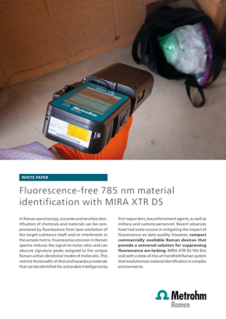Raman spectroscopy is a ubiquitous tool that can be used for many different purposes. From robots to art, and from beer to outer space, it’s unbelievable what a versatile technique Raman can be. Part 1 of this FAQ series covered theory and practical usage. This blog article aims to answer some frequently asked questions about the suitability of Raman spectroscopy for various applications.
Click on a question below to jump directly to that subject:
- What can Raman do that other techniques cannot?
- How do specialized Raman techniques support unique applications?
- What can Raman spectroscopy offer for exciting and unusual applications?
- How does Raman contribute to food and beverage analysis?
- What’s next for Raman spectroscopy at Metrohm?
- What makes Raman so powerful for illicit and hazardous materials applications?
- Which Raman applications and features stand out at Metrohm?

Many analytical methods, traditionally laboratory-based, can be used for material identification. Raman is a tool that identifies substances by matching them against a library of known compounds and/or verifies materials through comparison within a model set of data.
What sets Raman apart is its unique sampling capabilities. At its most basic level, a Raman user can gather data from a sample directly in its native form, and sometimes in its original packaging, by simply pressing the sampling attachment against the material or outside of a container. The benefits of this are speed and ease, no sample contact or potential for contamination, and no sample preparation. Handheld systems permit the user to enjoy all of these advantages outside of a laboratory, anywhere sampling is required. Consider additional capabilities like remote acquisition, robot or drone or vehicle-mounting, and standoff sampling from a distance, and you realize how unique Raman applications can be. Site inspection, Hazmat and CBRNE scenarios, space exploration, and illicit material detection are all possible without risking human safety.

Surface-enhanced Raman scattering (SERS) turns Raman into an excellent trace-detection technique. With SERS, it is possible to determine traces of pesticides in foods and to detect very small amounts of narcotics in complex street drug samples.
At Metrohm, SERS is even being proposed as a method for detecting narcotics in whole-blood samples.

Metrohm specializes in a combination of Raman spectroscopy and electrochemistry (EC-Raman) that obtains information about the chemical processes including simultaneous structural and functional information in a single experiment. EC-Raman can monitor electrocatalytic reactions, energy storage devices, and corrosion processes in addition to characterization of organic and inorganic compounds.

Utilizing Raman spectroscopy at a wavelength of 532 nm is ideal for the characterization of carbon. Peak intensity, shape, and position reveal information about the internal crystallinity of the sample and can elucidate structural disorder.
Raman spectroscopy has many beneficial uses in the field of art conservation. The benefits of using Raman spectroscopy over other analytical techniques include the noninvasive, in-situ study of cultural heritage objects, fluorescence-reduction capability for identifying pigments and dyes, and standoff measurements for non-contact analysis of surfaces from up to several meters away.
4. How does Raman contribute to food and beverage analysis?
The number of ways that Raman spectroscopy can be used for food testing is surprisingly large, and there are multiple approaches available for success.
6. What makes Raman so powerful for illicit and hazardous materials applications?
Raman spectroscopy is ideal for the identification of narcotics, potentially hazardous unknown chemicals, explosives, and chemical warfare agents. Operator safety is maximized with its ability to give no-contact results quickly and reliably at the scene. This is essential for applications involving illicit and hazardous materials as diverse as customs security, traffic stops, chemical spills, and surveillance of clandestine laboratories.

This is no accident—handheld Raman systems from Metrohm are designed for the rigorous specifications needed for these kinds of dangerous applications:
- Metrohm’s handheld Raman instruments are rugged: resistant to water and dust and certified to withstand shock and vibration.
- ID of hazardous materials is made safer with remote and delayed acquisition and instant hazard warnings.
- Resistive touchscreens and/or functional buttons enable use with gloves, even the ones on bulky Hazmat suits.
- The availability of multiple Raman wavelengths allows users to benefit from maximum sampling flexibility.
- Custom accessories (e.g., PowerPack for MIRA) support field-testing, even when it’s an all-day job.
7. Which Raman applications and features stand out at Metrohm?
Flexibility is key for cutting-edge Raman solutions from Metrohm. Many of our Raman systems are capable of the following:

See-through Raman permits rapid material identification through opaque containers and packaging materials previously impenetrable by Raman spectroscopy, including plastic bottles and multi-layer paper.
This supports applications such as incoming material ID, postal service package inspection, and detection of contraband at border and customs stations.

Metrohm has revolutionized handheld Raman with patented Orbital Raster Scanning (ORS™) and the Large Spot Adapter, which are proprietary ways of overcoming low resolution, poor sensitivity, and sample degradation while still interrogating a large sample area.
These state-of-the-art technologies improve analysis of mixtures, like many common pharmaceutical formulations. Because the laser is dispersed over the sample, it is also ideal for the interrogation of sensitive materials, such as highly colored and volatile substances.
Finally, the ability to suppress fluorescence in the Raman spectrum is essential for both qualitative and quantitative applications, including fuels, polymers, and paints/dyes. Metrohm offers methods for fluorescence-suppression at the most-used Raman wavelengths.
Conclusion
Raman offerings from Metrohm are as diverse as the application possibilities. Handheld and laboratory Raman systems cover the full spectrum—trace detection, material verification, identification of unknown substances, all the way to quantitative analysis. No matter how it’s used, Raman is a unique and wonderful form of spectroscopy!
Your knowledge take-aways
Application Note: Choosing the Most Suitable Laser Wavelength For Your Raman Application
Application Note: Orbital Raster Scan (ORS™) – Safer, more representative sampling with 785 nm Raman
On-demand webinar: Biomedical Applications of Raman Spectroscopy
 Cikk megosztása
Cikk megosztása







